WAKA/JAWAKA: THE JAZZ COMBO
Confined to a wheelchair at the beginning of 1972, Zappa returned to the idea of composing jazz music, that had worked out well on "Hot Rats".
Meanwhile Flo and Eddie, with no new projects announced for them, left the group and started touring on their own.
In the summer of 1972, as a sequel upon "Hot Rats", "Waka/Jawaka" was released first, to be followed by "The Grand Wazoo" at the end of this year.
At this time Zappa worked with trained session musicians, who could read sheet music. The members of the band were given a book, being
a set of a dozen of scores of the pieces they were expected to play. See fig. E from the booklet that comes along with the 2007 "Wazoo" release
by the ZFT. Relatively much handwritten sheet music by Zappa himself from this period is circulating.
There are a couple of samples and thumbnails from the original scores included in this section and the following two. Apart from that Wolfgang Ludwig has transcribed
much of the composed lead melodies from Zappa's jazz music in his study, using them
frequently for his analysis.

Part of the album frontside cover, referring to the earlier "Hot rats" album. The first CD re-issue on Zappa records from 1988, serial number CD ZAP10,
wasn't re-using the backside photo (see below at track 4). It also doesn't mention who drew the cover.
1. Big swifty (1972)
"Big swifty" wasn't a large composition from the start. On the "Joe's Domage" CD by the ZFT its opening themes are played in combination
with "The new brown clouds", lasting 2:44 in total (see below at "Frog song" for some more about this CD).
"Big swifty" eventually became big by adding an outchorus
and a lot of improvisations. All opening themes from this composition, their structure and coherence get a lot of attention in the Ludwig study.
An official arrangement by Jon Nelson is on the Barfko Swill list from the ZFT site (available for rent only).
Several points taken from Ludwig's analysis of "Big swifty" are presented below, concerning for instance the use of meters and rhythms. Roughly this title
can be subdivided into a number of blocks (see below for Zappa's own section division of the written score):
Opening themes.
- 0:00 Themes 1-2.
Changes of meters as well as tempo changes are characteristic of the opening block. Given here are the first
two themes that are using a 7/8 and 3/4 alternation. The Ludwig study, pages 92-97, gives an overview of all meters used
and an explanation how Zappa could use meters and thematic/motif variations as a way of structuring a song. On top of that
you've got tempo changes. Zappa himself writes in the "Wazoo" booklet: "This piece (which comprises all of side one of the Hot rats-Waka/Jawaka album)
presents a theme in rapidly alternating time signatures, a few solos, and an outchorus done up in a sort of Prom Night orchestration
which suspends the opening rhythmic structure over a straight 4/4 accompaniment."
The two opening bars below are built around an F#-G movement, by itself suggesting the key of F# Phrygian.
The descant of the piano part also begins with a I-II alternation in this key, while the bass points more at E Dorian with the I chord.
With the melody ending on E for the first two themes the general key tends more towards E Dorian. The outro part below is also in E Dorian.
Big swifty, opening bars (midi file).
Big swifty, piano part, opening bars (midi file).
Big swifty opening, first two themes of the opening (transcription).
Big swifty, piano part, opening bars (score).
Whereas the CD executions on "Waka/Jawaka" and "Make a jazz noise here" of this song could serve as an example of
a melody that's played as a single melody or in parallels, the piano part for this composition shines a different
light upon its construction. I only encountered it on the net around 2010. This piano part hasn't been actually used in
any "Big swifty" performance, also not in the two versions on the ZFT releases. It's in Zappa's own handwriting and shows
that at least at one point he had a harmonized version of "Big swifty" in mind. It changes the character of this
piece significantly, making it move from jazz to modern music. The descant chords, apart from the arpeggios, form a normal 5th
chords progression. The bass chords,
however, are adding extra notes not being part of these 5th chords, so the whole becomes a progression of enlarged chords. Most of the
time relatively consonant, but in bars 9-10 and 13-14 the juxtaposition of F# and G in the bass make it dissonant. It's
a further example that shows that Zappa's original scores often don't correspond one on one with what's on record. They
can be different versions by themselves as well. It's also known that Zappa tried out his players to find out what
they could maximally do and by doing so he also presented them compositions that
crossed the line of what's doable. So there
must be sheets with music that never has been performed at all and that could theoretically be premiered today via digital
executions.
- 0:23 Theme 3 in 5/8 and 3/4.
- 0:38 Theme 4 in 4/4 (bars 43-46 in the second example below).
- 0:45 Theme 5 in 3/8, 6/8 and 5/8 (bars 47-56).
- 0:52 Theme 6 in 4/4 (from bar 57 onwards).
Big swifty, themes 4-6 (transcription).
Free improvisation block #1.
- 1:12 Band members are playing at lib. over an F pedal.
Solos, block #1.
- 2:10 Soloing over a I-II alternation in E Phrygian. The solo begins with George Duke on keyboard, next Sal Marquez takes over on trumpet,
followed by Zappa on guitar. George and Sal continue soloing in the background when Frank is playing, to a degree becoming a trio.
In his response to me Brett Clement names the scale in this part the E Phrygian dominant scale (E-F-G#-A-B-C-D).
This Phrygian variant does occur in this block, especially during the keyboard part (e.g. between 2:33-2:42). Mostly it's standard Phrygian as in the example below.
Big swifty solo, 5:48-6:04 (midi file).
Big swifty solo, 5:48-6:04 (transcription).
- 8:12 Transition. Zappa is improvising and varying some motifs. Tony Duran joins in on slide guitar, responding to these motifs.
Solos, block #2.
- 9:27 Second block with both guitars soloing. Both E Mixolydian and E Dorian are coming by. The following is an outtake from
the section in E Mixolydian with Tony and Frank playing some sort of a duet on guitars. George Duke plays the keyboard part
and Alex Dmochowski bass. The latter credited as "Erroneous".
Big swifty solo, 9:42-9:57 (midi file).
Big swifty solo, 9:42-9:57 (transcription).
- 11:43 Transition with some more improvising and varying of motifs.
Outchorus.
- 13:17 The outchorus begins with varying material from the opening in slower tempo and a different meter, now standard 4/4.
The scheme from below points at returning motifs during themes 1-3 and 5 from the opening, being transposed and occasionally
lightly varied upon. These relationships build a coherence between these themes. Theme 4 however, stands by itself, using only B-C#-D as notes.
Big swifty, melodic relationships.
Included in this last example are the opening bars from the outchorus where you can recognize three variations upon theme 1 from above.
Theme 1 knows to phrases and you can see that material from both phrases re-appears in these variations.
The next example below begins with a variation upon theme 2.
- 13:39 During the outchorus a simultaneous use a two different tempi occurs, beginning at 13:40. While the drummer keeps beating the tempo from the
beginning of the outchorus, followed freely by the bass guitar, the brass holds back at a 2:3 tempo.
The two tempi cause some polyrhythmic interaction between the brass and the rhythm section.
Big swifty outchorus, fragment (midi file).
Big swifty outchorus, fragment (transcription).
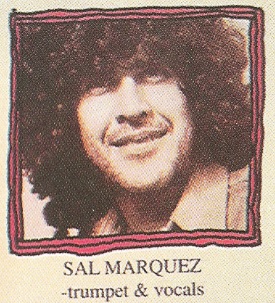 The transcription above contains two notational
variants. As mentioned above Zappa talks about a Prom Night arrangement.
He further mentions that for this outchorus a "rhythmically deranged" guitar solo was also made use of, a solo that trumpet player
Sal Marquez had transcribed and that should be present on the "Waka/Jawaka" album. So far I haven't been able to figure this out.
Sal heavily contributed to "Big swifty"
for taking care of all (overdubbed) brass parts. After a brief fall-out for having dared to ask for an advance, Sal returned
in 1973 for the "Overnite sensation" CD. To the right
the photo by Emerson-Loew of Sal Marquez from this last CD.
The transcription above contains two notational
variants. As mentioned above Zappa talks about a Prom Night arrangement.
He further mentions that for this outchorus a "rhythmically deranged" guitar solo was also made use of, a solo that trumpet player
Sal Marquez had transcribed and that should be present on the "Waka/Jawaka" album. So far I haven't been able to figure this out.
Sal heavily contributed to "Big swifty"
for taking care of all (overdubbed) brass parts. After a brief fall-out for having dared to ask for an advance, Sal returned
in 1973 for the "Overnite sensation" CD. To the right
the photo by Emerson-Loew of Sal Marquez from this last CD.
Free improvisation block #2.
- 14:51 Some more rather free improvisations by all band members in E Dorian.
- 17:21 End.
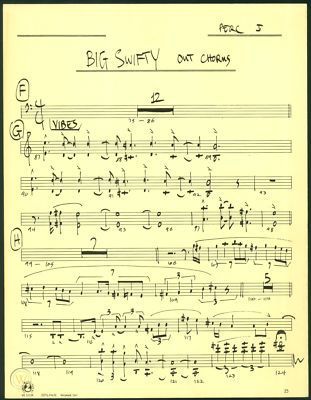
In 2023 I came across an example from the orginal Outchorus score. It's the percussion part for the vibes, handwritten by Zappa.
Section G corresponds with the outchorus fragment from above by Ludwig and me. It's not well legible, but the bar numbering seems to go as:
Bars 75-86: section F.
Bars 87-98: section G.
Bars 99-124: section H.
The piano part of the opening, referred to as Part I of the composition, contains:
Bars 1-16: opening theme.
Bars 16-20: start of section A.
See the Make a jazz noise section for a live version of "Big swifty (1988)".
Two examples are included, with the first one containing the 1988 arrangement of what is called theme 6 above.
One might call this 1988 version modern jazz with the improvising being atonal, while the synclavier adds an experimental element to it.
2. Your mouth
"Your mouth" and for instance "For Calvin" from the next "The grand wazoo" album are more stable in the use of their meters.
"Your mouth" is in 12/8 and the transcribed part below is in C Dorian. See the next section
at "For Calvin" for a comparison of the element of improvisation during these two songs.
Other than "For Calvin", "Your mouth" has just the melody prescribed, but this melody lasts all through. All instruments are
playing freely around this theme. There's no improvisation block in this song.
Your mouth, section (midi file).
Your mouth, section (transcription).
Like "Hot rats", "Waka/Jawaka" and "The grand wazoo" are largely instrumental albums. "Your mouth" has lyrics like a regular popsong. The next track only
at the beginning, as does
"For Calvin", the only track on "The grand wazoo" with lyrics. During the 1972 fall tour with this jazz band, the lyrics were skipped altogether.
A couple of tracks did originally or later on have lyrics, like "Penis dimension", the "New brown clouds" and "The grand wazoo" at the time it
was called "Think it over". This shows that the presence of lyrics has little influence upon Zappa's musical writing styles. More about this
in the Make a jazz noise here section at "Let's make the water turn black".
3. It just might be a one shot deal - Frog song
"It just might be a one shot deal" consists of three theme blocks with two intermezzi along
the way. Its structure goes as:
Beginning with most bars transcribed below:
0:00 Theme A. The song begins with a bass vamp of two bars with some improvised harmony over it. The singer begins
in swing-time 4/4. The key is E Mixolydian.
1:13 Theme B with vocals. The bass plays a melody of its own in G against the sung melody.
1:24 Intermezzo I. The song now continues chromatically, ending with a dissonant chord B-Bb-E.
Remainder of the song:
1:47 Theme B with guitar solo.
3:18 Intermezzo II.
3:38 Theme C.
It just might be a one shot deal, opening (midi file).
Frog song, fragment (midi file).
It just might be a one shot deal/Frog song, opening (transcription).
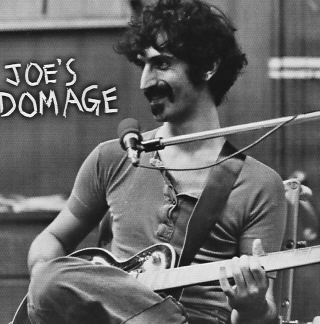 Intermezzo I however moves on in a peculiar way. Zappa recorded an early rehearsal on an ordinary cassette tape (mono and
dim sound), probably to get an impression of the result that far. The band had been studying the scores and was now
playing through the parts with Zappa present in his wheelchair and a guitar on his lap to demonstrate things. They were
already able to play the music at a demo level and what Zappa basically does is some extra explanation and
sharpening the accuracy of the performance.
The
Zappa Family Trust has put the tape on CD as "Joe's domage", which includes this piece as the rehearsing of the "Frog song".
It's not much of public interest the way it has been brought out. It would have been a lot better to help people
follow the process by including the
scores that Zappa had handed over in a booklet. Now you get only half of the picture, but it did help
me out to get an idea of this intermezzo I (see the transcription for the details with Zappa counting through it). Straight from record
and without any clue it's sort of a jigsaw puzzle. The photo
to the right shows Zappa sitting in his wheelchair during a rehearsal session in 1972 (source: "Joe's domage" CD cover, copyright ZFT).
Intermezzo I however moves on in a peculiar way. Zappa recorded an early rehearsal on an ordinary cassette tape (mono and
dim sound), probably to get an impression of the result that far. The band had been studying the scores and was now
playing through the parts with Zappa present in his wheelchair and a guitar on his lap to demonstrate things. They were
already able to play the music at a demo level and what Zappa basically does is some extra explanation and
sharpening the accuracy of the performance.
The
Zappa Family Trust has put the tape on CD as "Joe's domage", which includes this piece as the rehearsing of the "Frog song".
It's not much of public interest the way it has been brought out. It would have been a lot better to help people
follow the process by including the
scores that Zappa had handed over in a booklet. Now you get only half of the picture, but it did help
me out to get an idea of this intermezzo I (see the transcription for the details with Zappa counting through it). Straight from record
and without any clue it's sort of a jigsaw puzzle. The photo
to the right shows Zappa sitting in his wheelchair during a rehearsal session in 1972 (source: "Joe's domage" CD cover, copyright ZFT).
The transcription of this section from "But you should ..." onwards is based upon some indications given during
a rehearsal session that Zappa put on tape. The final version is also not entirely identical to
the early rehearsal version. The "Frog song" example above is how I interpret the rehearsal of this section.
The unit of timing as presented by Zappa remains the quarter note ((one)-two-three-four) and the 16th note (be-bop).
First the quarter notes are played as triplets. The peculiar thing about this construction is that the first note of the triplet figures
starts at the end of a bar. The figures then continue in the next bar, but with an odd number of notes.
This is causing some notational problems. In the "Frog song" example I've notated this without a meter but with Zappa's counting along with it.
In the "It just might be a one shot deal" example I did use normal meters, but then you need some sort of trick, a change to triplet time for a bar with
eight notes in it. Next you get the be-bop figure, which ends with a note lasting 4/4.
Points during the "Frog song" with Zappa counting or indicating the rhythm, and asking the band how to memorize it:
- 6:43-6:45: "be-bop-be-bop bop bop" ("bar" 3 from my example).
- 6:58-7:05: "no, [doesn't] take time to actually write out the rhythm of that thing, just listen to it and [play] it simple ..." (idem, that is memorize it as it sounds).
- 7:57-8:04: "now, that's following the line of the speech which is: but you should be digging it while it's happening" ("bar" 2 from my example, with Zappa pointing
at the speech influence). The first word "but" is sung as the last note from "bar 1", while the syllable "-ning" from "happening" coincides with the 6/16 bar.
- 11:16-11:21: "one-two-three-four" ("bar" 1 from my example).
- 15:16-15:23 and 16:06-16:09: "two-three-four" ("bars" 4-6 from my example).
It's a very weird thing to do, setting up a rhythmic construction like this, but it's something Zappa loved to do. Other parts from this song are relatively normal,
like mainstream pop, and this intermezzo completely breaks the patterns. Two little changes were made later on. The lyrics went from "... while it's happening" to
"... what this might be", thus the D falls out, having one syllable less to play. "... While
it's happening" now gets superimposed as spoken text. The second 4/4 appears to have been
augmented to 5/4 with free percussion figures starting. The duration of the first Bb got doubled,
the note that begins this melody at the end of the previous bar.
As also noted by Josh Oxford in his dissertation Scrutinizing Frank Zappa's "The adventures of Greggery Peccary", the "Frog song"
melody from above is also present in the "New brown clouds" block from "Greggary Peccary". On "Studio Tan" it can be heard between 17:01 and 17:05, where it has no lyrics.
I've added the original score of it below the example from above. It is yet another version of this melody.
The notes are the same, but the rhythm is somewhat different, an "isomelism", as Brett Clement would say.
4. Waka/Jawaka
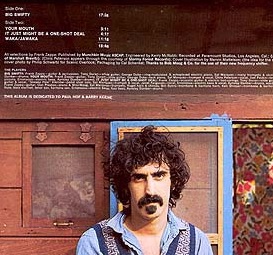 Both "Waka/Jawaka" and "Blessed relief", the closing numbers of the two CDs of this section and the following section, can be seen as variation pieces, where themes return several times
in different set-ups. These two pieces can also be presented as modulation schemes, both for the written themes as for the soloing. Every couple of bars the
bass pedal changes to a different note, causing a change of scale. "Waka/Jawaka" begins with theme I, stated twice in a different form. The theme itself
can be seen as made up of two phrases, that can be interpreted as character variations upon each other. Not the whole melody gets varied upon, but some of its characteristics.
For instance the rhythm of the first bar of both phrases goes identical. Both phrases lead to a sustained note at the end. For phrase one it's the highest note, while
for phrase two it's the lowest note. The Ludwig study presents the lead melody on page 260 (first statement). The first example below begins with the second statement of the second phrase
with the following set-up:
Both "Waka/Jawaka" and "Blessed relief", the closing numbers of the two CDs of this section and the following section, can be seen as variation pieces, where themes return several times
in different set-ups. These two pieces can also be presented as modulation schemes, both for the written themes as for the soloing. Every couple of bars the
bass pedal changes to a different note, causing a change of scale. "Waka/Jawaka" begins with theme I, stated twice in a different form. The theme itself
can be seen as made up of two phrases, that can be interpreted as character variations upon each other. Not the whole melody gets varied upon, but some of its characteristics.
For instance the rhythm of the first bar of both phrases goes identical. Both phrases lead to a sustained note at the end. For phrase one it's the highest note, while
for phrase two it's the lowest note. The Ludwig study presents the lead melody on page 260 (first statement). The first example below begins with the second statement of the second phrase
with the following set-up:
- staff 1: the lead melody played in the form of a series of chords involving three notes. Most chords are triads, but in bar 2 you also have a 7th chord and
a stacked fourth.
- staff 2: a high pulsing fourth. Per beat you have three possible appearances of its rhythm, indicated as a, b and c in the example. The following order
is consistently a-b-c, thus by itself more as if in 3/4, while "Waka/Jawaka" is in 4/4 all through.
- staff 3 (bars 1-2) and staff 4 (bars 3-4): another pulsing combination in the same rhythm. Here it's a third, E-G# in bar 1, followed by C#-E in bars 2-4.
In bar 4 this third gets interrupted twice by a fourth. As on "Hot rats", overdubbing is used to let a relatively small band sound as a big band.
- staff 3 of bar 3: some more harmonic enrichment, lightly audible in the background.
- staff 4 (bars 1-2) and staff 5 (bars 3-4): a repeated bass figure functions as a counterpoint line. For phrase 2 this figure is a variation upon the bass figure
for phrase 1. The figure for phrase 1 keeps returning during the piece.

It must be this pulsing accompanying chord about which Brett Clement writes the above citation on page 152 of his 2014 article. In A Lydian the indicated
chord would be C#sus2, C#-D#-G#, with D# and G# indeed being the lead tones in A Lydian. I'm hearing this accompanying chord a bit different, but in combination
with the chords of the lead melody all harmonic possibilities of the A Lydian scale can be heard. More about this subject can be found in the Zoot allures section of this study
at the block about unstable chords in Brett's Lydian systems.
Waka/Jawaka, theme I - trumpet solo, transition (midi file).
Waka/Jawaka, guitar solo, opening (midi file).
Waka/Jawaka, theme I - trumpet solo, transition (transcription).
Waka/Jawaka, guitar solo, opening (transcription).
The general construction and the modulation scheme of "Waka/Jawaka" go as:
0:00-0:51: Theme I in A Lydian as described above. This theme is immediately followed by a long period of soloing, thus it takes a while before we get back at
another composed section.
0:51-1:41: Trumpet solo. The three pedal notes for the solos are F, A and G. Every couple of bars they alternate with each other. The scale used over these pedal notes
is of the major type, rather than one specific scale. Mostly the Lydian scale from theme I returns, but players can also chose for major or Mixolydian.
It can also happen that two scales happen simultaneously. As already mentioned above this is a returning feature in Zappa's music. One that complicates
the analysis of his music. It's standard to identify scales, but Zappa's attitude towards scales is ambiguous. Frequently one is forced to listen to all individual
notes, chords and bass line included, to be positive what scale the music is using during a specific period. Sal Marquez begins his trumpet solo in F major, as
you can see and hear in the first example.
1:41-4:43: Keyboard solo. On one occasion you have F# as a pedal note in combination with a minor type of scale (2:47-2:57). In this context this F# can best be interpreted as
a pedal substitution for A.
4:43-6:31: Guitar solo. This solo begins with Zappa choosing for A Mixolydian (bars 1-4 of the second example), followed by two bars in G Mixolydian. Next the
band returns to the A Lydian key from theme I. This is first indicated by Don Preston on keyboards, who is alternating the E and G#m chords. At 5:22
the solo briefly turns over to A Dorian, first indicated by the Am chord by the accompanying guitar.
6:31-6:44: Theme II, in A Lydian for its first statement.
Waka/Jawaka, theme II and opening of theme III (midi file).
Waka/Jawaka, theme II and opening of theme III (transcription).
In May 2023 Jonathan Pontier sent me his arrangement of "Waka/Jawaka", of which I'm here presenting theme II (referred to as section D, "Chant", in his score).
Jonathan has my bars split into two. Bars 1-8 are phrase one of this theme. The descant part is played unisono by the band with the bass continuing with improvising along the figure from theme I.
Letting a band play unisono is something Zappa rarely does. See the Sinister Footwear section from this study at the instrumentation block for this topic.
In all other examples from "Waka/Jawaka" you can see chords being used. This unisono part contrasts sharply with the end of theme III from below. Maybe
it was this contrast Zappa was looking for on this occasion. In bars 9-12, the second phrase of theme II, the harmonies return.
6:44-7:22: Theme III, made up of two phrases (in F and A Lydian respectively). The first phrase is a single upwards moving melody, leading to phrase two at 7:09.
7:22-8:04: Drum solo.
8:04-9:07: Theme I returns.
9:07-9:19: Theme II, transposed down a major third. The pedal note, however, switches from A to D instead of F, causing the scale to become D Dorian.
Waka/Jawaka, theme III, end (midi file).
Waka/Jawaka, theme IV, fragment (midi file).
Waka/Jawaka, theme III, end (transcription).
Waka/Jawaka, theme IV, fragment (transcription).
9:19-9:45: Theme IV. This theme is made up of two phrases that get repeated. The melody follows two different diatonic scales. The bass plays a D-E alternation
during the first phrase and a D-C alternation during the second. In both cases the D is a chromatic note in relation to the scale of the melody and the harmony.
Thus this D can better be taken as a passing-through note for the second bass note. It sets the key to E major for the first phrase and C Locrian for the second.
The latter scale is an obscurity, in music in general and in Zappa's music as well. The accompanying chord progression is II-V and VI-V respectively.
9:45-10:35: Theme II returns once more, now with the descant melody transposed up a minor third, while the bass is doing over a D-C alternation.
So this last time this theme is played in D Mixolydian.
10:35-11:19: Theme V in D major.
Waka/Jawaka, theme V, opening (midi file).
Waka/Jawaka, theme V, opening (transcription).
The third "Waka/Jawaka" example presents part of theme three. It contains the last two bars of its first phrase, an irregular upwards moving melody, leading
to the sound blast of its second phrase (bars 3-6 of the example). Again Zappa is using overdubbing to let a smaller band sound as a big one. Over an
improvised bass line you have two prescribed brass chord progressions, completed with a third melody for keyboard/guitar in staff 3. In staff 1 you mostly
encounter the II, I and VI chords. Staff 2 is mostly a VI-I 7th alternation. The bars keep varying their rhythm, so the total sounding combination of notes
keeps varying as well. Another example of Zappa using a scale as a harmonic field: all combinations of the seven scale-notes can turn up.
"Waka/Jawaka" ends in D major with the bass playing I-V-I-IV over a period of two bars, a variant upon a traditional cadence, fading out (the last example above). Again you have
some ambiguity about the scale,
because the C chord during beats 3-4 in bar 1 belongs to D Mixolydian, but for all other instances it's C sharp. Yet again Zappa is using a pulsing accompanying
chord. This time it's rhythm is without a specific pattern, as there was during the first example. The notes of the chord aren't constant. It's D-add2 for bar 1 and beats 3-4 of bar 2.
During beats 1-2 of the second bar it's Dsus4-add2.
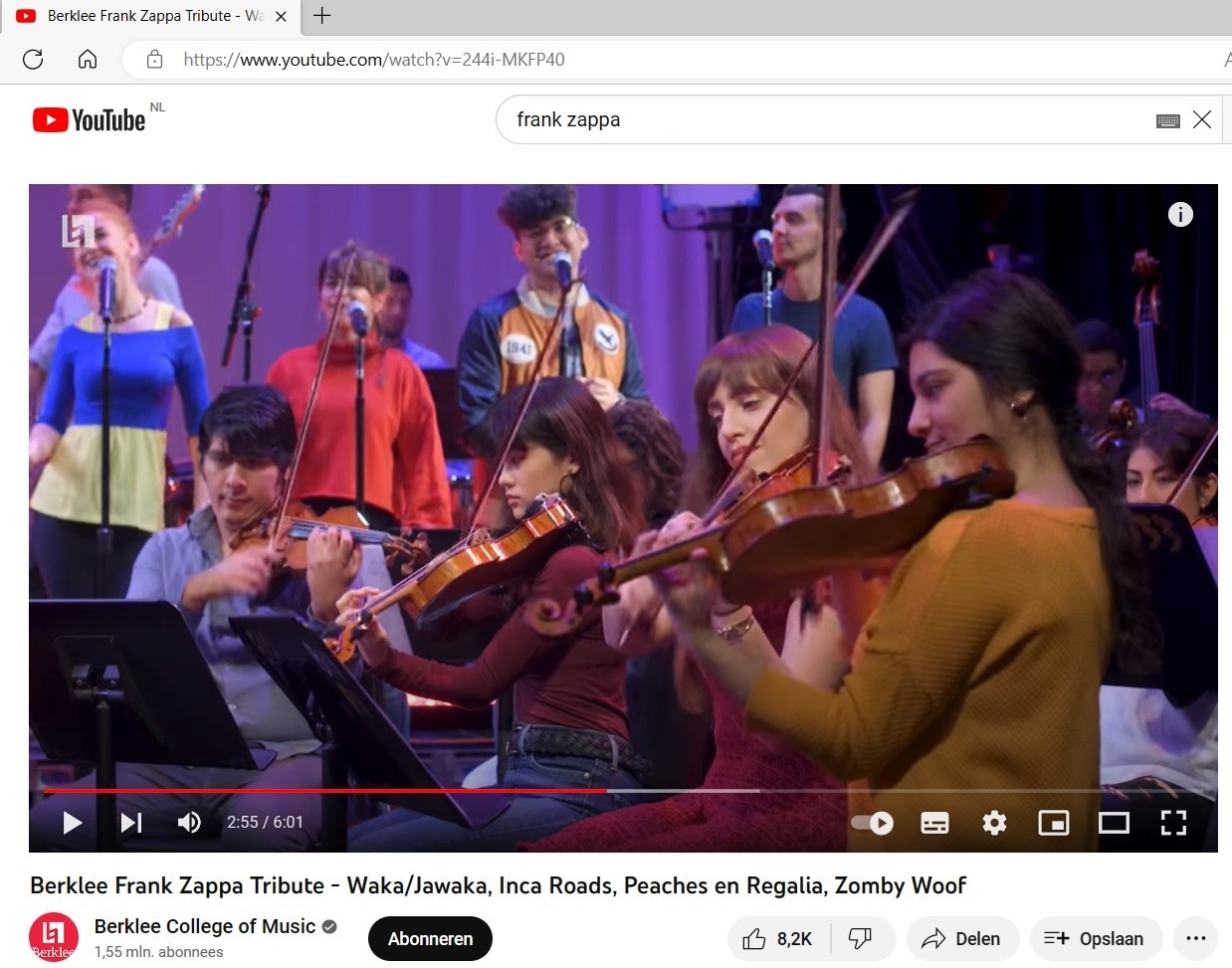
YouTube image of the Berklee College of Music and Boston Conservatory at Berklee students paying
tribute to Frank Zappa performing a medley of "Waka/Jawaka", "Inca Roads",
"Peaches en Regalia", and "Zomby Woof" at the Berklee Performance Center.
Waka=Jawaka sketch
On pages 114-5 from the Frank Zappa songbook vol. I a page with a manuscript is included, which Zappa describes as "the first sketch from the recording
session of Waka-Jawaka". It carries the title "Waka=Jawaka". Word has it that he encountered these syllables on a sign and apparently he liked the sound
of it. In English it's meaningless. He liked toying with words as in finding new combinations ("zoot allures") or coming up with something not yet existing
("the grand wazoo" standing for a prototype megaphone, as explained in the CD booklet). It creates some degree of confusion, in my opinion intentional, which
can also be said about this page of manuscript. All other included manuscripts are notated in a standard manner, but this sample got
notated thus swiftly and loosely, that probably only Zappa himself could follow it.
Chord sequence from the 3rd staff (midi file).
Waka=Jawaka sketch (notes).
Two staves are combined as
if in a 4/4 meter, but it's not notated like that and I even doubt if these staves were indeed meant as to be played together. In it a couple of atonal
chord progressions can be detected. My guess is that Zappa notated a couple of things to remember them with, to be worked out later.
The midi file from above contains the notes from the third staff from the sketch (counting from above). Nothing resembles a released song, so it's another example of
something existing on paper only. In this case the sketched material is too limited to distract a composition from it.
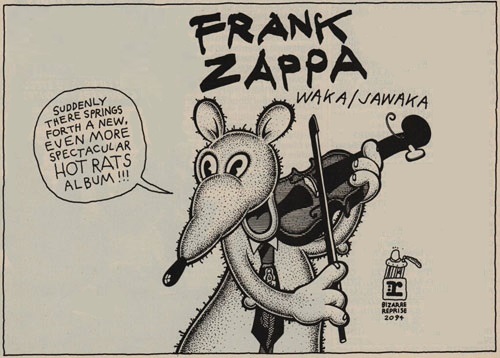
The mouse drawing Zappa used for advertising for "Waka/Jawaka".
